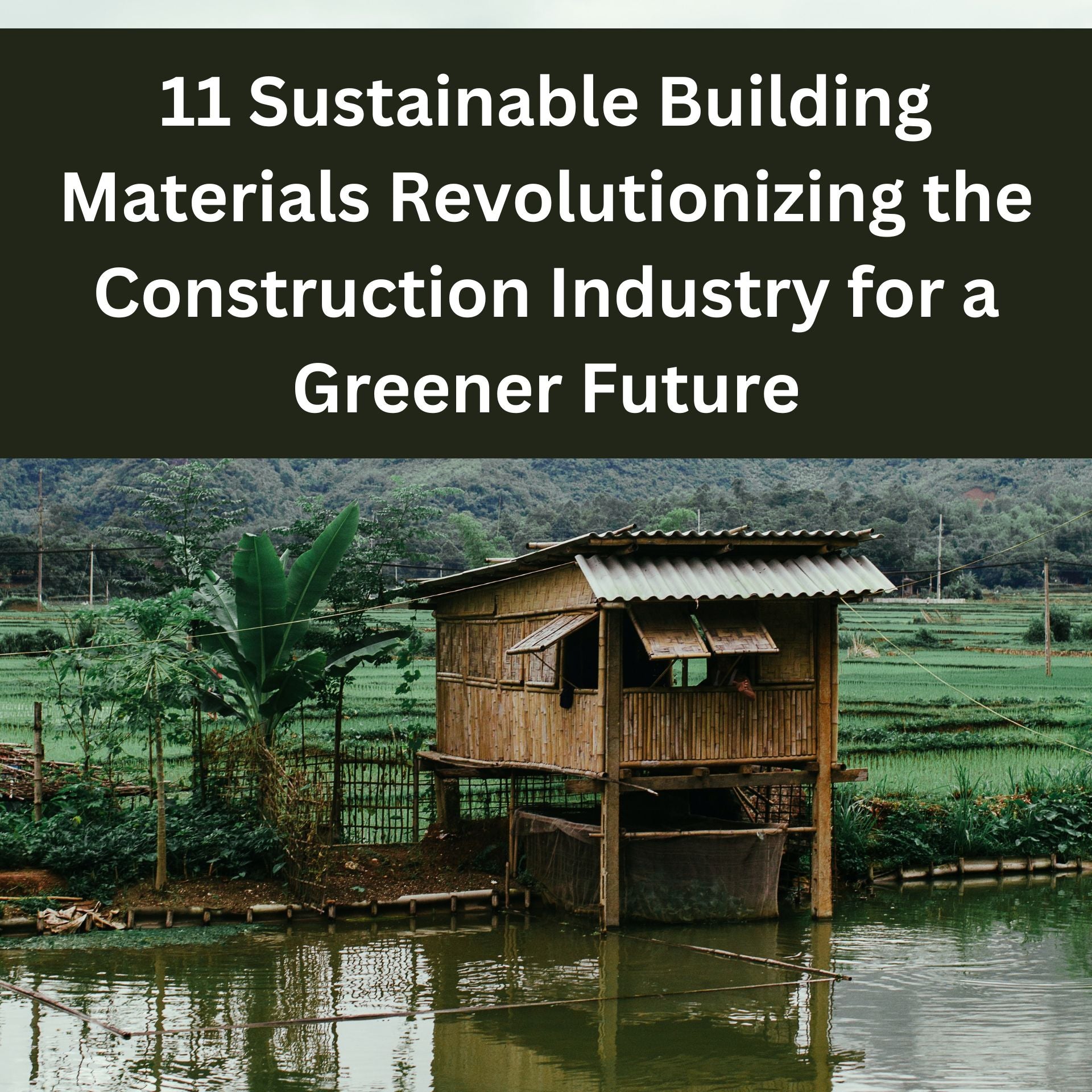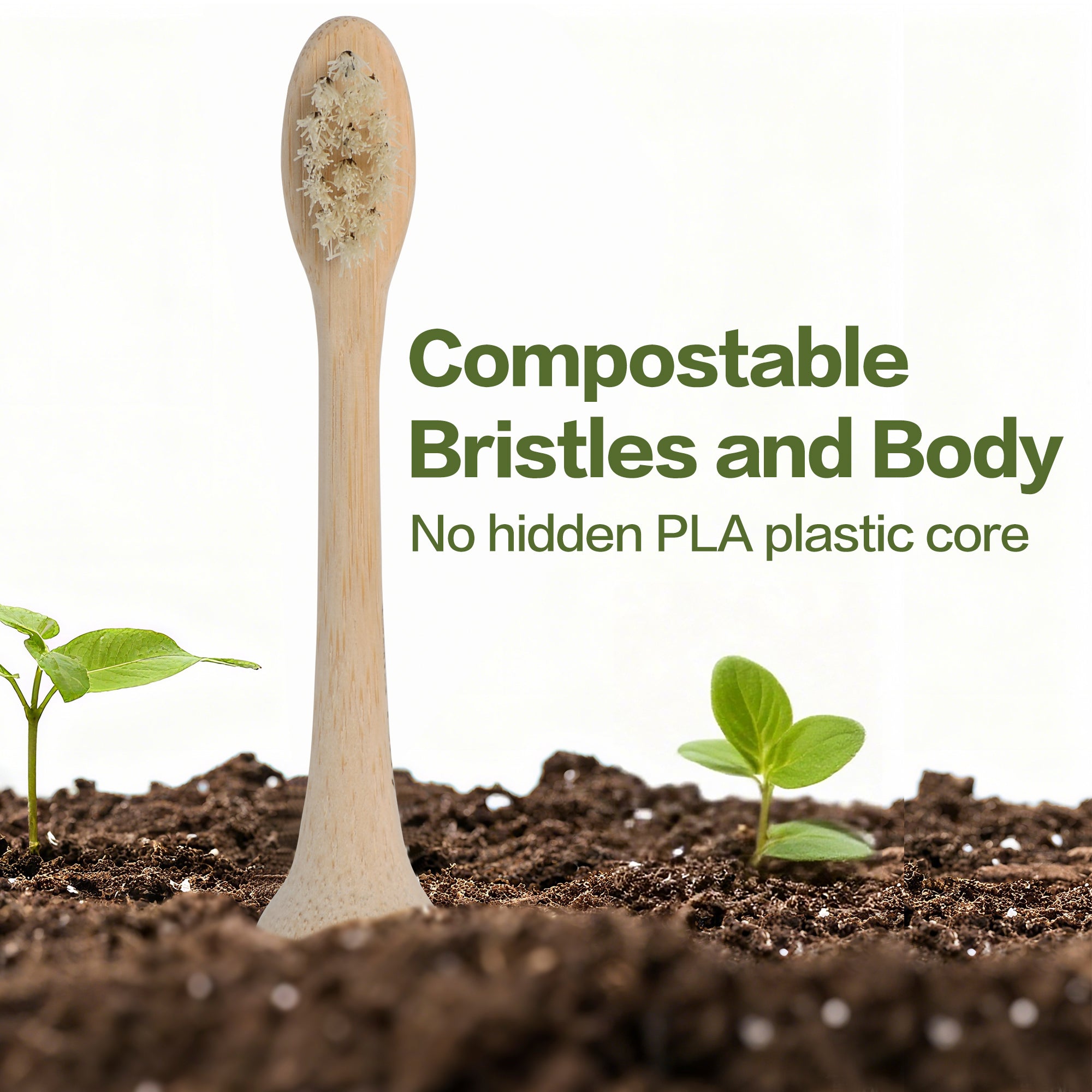There is an increasing demand for sustainable building materials, however a lot of people still aren't aware of the amazing sustainable building material alternatives. Here we present some green building materials that can help us reduce our carbon footprint.

These materials not only reduce the environmental impact of construction but also offer numerous economic benefits. In this article, we explore eleven sustainable building materials that are revolutionizing the construction industry and how they contribute to a greener future.
1. Recycled Steel
Recycled steel is one of the most eco-friendly and sustainable building materials available. By utilizing steel already in existence, we can significantly reduce the energy consumption and carbon emissions associated with manufacturing new steel. In fact, recycling steel saves 75% of the energy costs compared to producing new steel from raw materials.
Advantages of Recycled Steel:
- Environmentally friendly: Steel is the most recycled material in the world, reducing the demand for new steel production and its high levels of carbon emissions.
- Cost-effective: Using recycled steel leads to substantial cost savings for builders and homeowners as the cost of fossil fuels continues to rise.
- Strong and durable: Recycled steel has the same structural integrity as new steel and can be used in various applications, including structural support and framing.
FAQs:
How is recycled steel obtained for construction projects?
Recycled steel is obtained through a process called metal recycling, where scrap steel is collected, sorted, and processed to be reused in new construction projects.
Can recycled steel be used for load-bearing structures?
Yes, recycled steel can be used for load-bearing structures. It has the same strength and durability as new steel and meets the necessary structural requirements.
What are the cost savings associated with using recycled steel?
Using recycled steel can lead to significant cost savings for builders and homeowners due to the lower energy costs and reduced need for new steel production.
2. Bamboo
Bamboo is another sustainable building material that is rapidly gaining popularity in the construction industry. Due to its fast growth and ability to be reforested promptly, bamboo is an incredibly renewable resource.
Advantages of Bamboo:
- Sustainability: Bamboo can be harvested and replanted much more quickly than traditional lumber, making it a highly sustainable option for construction.
- High strength-to-weight ratio: Bamboo has a higher compressive strength than wood, brick, or concrete and a tensile strength that rivals steel, making it suitable for various structural applications.
- Versatility: Bamboo can be used in a wide range of construction projects, from flooring and paneling to structural support and roofing.
FAQs:
Is bamboo as durable as traditional timber?
Yes, bamboo is highly durable and can even surpass the durability of some traditional timber. When properly treated and maintained, bamboo can last for many years.
How does bamboo compare to other materials in terms of fire resistance?
Bamboo has natural fire-resistant properties, making it a suitable choice for construction. However, its fire resistance can vary depending on the specific treatment and finish applied to the bamboo.
Can bamboo be used in construction in regions with cold climates?
Bamboo can indeed be used in construction in regions with cold climates, but certain factors need to be considered. Selecting cold-hardy bamboo species, like Moso bamboo, is important for withstanding freezing temperatures.
Proper treatment and preservation methods, such as curing, drying, and applying protective coatings, can enhance bamboo's durability and resistance to cold weather. Incorporating insulation and combining bamboo with other materials, such as timber framing, can improve thermal performance. Careful attention to species selection, treatment, insulation, and construction techniques is necessary to ensure bamboo's performance and longevity in cold climates.
3. Sheep’s Wool
Sheep's wool insulation is an eco-friendly and renewable option for insulating walls, ceilings, and attics. This natural building material possesses excellent thermal properties, contributing to energy-efficient spaces and maintaining comfortable indoor temperatures year-round.
Advantages of using Sheep's Wool Insulation:
- Sustainability: Sheep's wool is a sustainable choice as it can be regrown quickly. Its renewable nature aligns with the principles of sustainable building practices, reducing the environmental impact associated with insulation materials.
- Energy efficiency: With its superior insulating capabilities, wool insulation minimizes heat transfer through walls, ceilings, and attics. This leads to reduced energy consumption and lower heating or cooling costs, promoting energy efficiency in buildings.
- Health benefits: Wool insulation is non-toxic and hypoallergenic, making it a safe option for those with allergies or sensitivities to synthetic insulation materials. It does not release harmful gases or particles into the indoor air, ensuring a healthy and comfortable living environment.
Frequently Asked Questions about Sheep's Wool Insulation:
Is Sheep's Wool Insulation fire-resistant?
Yes, sheep's wool insulation has natural fire-resistant properties, making it a safer option for building insulation.
Can Sheep's Wool Insulation absorb and release moisture?
Yes, sheep's wool insulation can indeed absorb and release moisture. Wool has natural properties that allow it to absorb moisture from the surrounding environment when the atmosphere is damp and release it when the atmosphere becomes dry. This ability to regulate moisture makes sheep's wool insulation an effective choice for maintaining balanced humidity levels in a room.
How does Sheep's Wool Insulation compare to other insulation materials in terms of soundproofing?
Sheep's wool insulation provides excellent sound absorption properties, effectively reducing noise transmission within buildings and creating quieter spaces.
4. Straw Bales
Straw bales are a highly sustainable and energy-efficient building material renowned for their excellent insulation capabilities. When used in walls, ceilings, and attics, straw bales contribute to the creation of eco-friendly structures that maintain comfortable indoor temperatures year-round.
Key advantages of Straw Bale Construction:
- Sustainability: Straw bales are derived from agricultural byproducts and can be harvested and replanted with minimal additional environmental impact. Using straw as a building material promotes resource conservation and reduces waste.
- Energy efficiency: Straw bale construction offers effective insulation against heat transfer, minimizing energy consumption for heating and cooling. The thick walls of straw bale structures provide excellent thermal resistance, resulting in energy-efficient buildings.
- Affordability: Compared to traditional insulation materials, straw bales are often more cost-effective. Their affordability makes them an attractive choice for budget-conscious builders and homeowners, allowing for sustainable construction at a lower cost.
Frequently Asked Questions about Straw Bale Construction:
Are straw bales durable and long-lasting?
When properly protected from moisture and pests, straw bales can be durable and long-lasting. Appropriate plastering and sealing techniques ensure the longevity of straw bale structures.
Can straw bales be used in all climates?
Yes, straw bales can be used in various climates. However, proper design considerations, such as adequate insulation and moisture management, are essential for optimal performance in specific climate conditions.
Are straw bales fire-resistant?
Densely packed straw bales are fire-resistant. To improve fire resistance, straw bale construction often involves lime and/or clay plastering the exterior and interior surfaces which makes them more fire-resistant.
5. Geopolymer Concrete
Geopolymer concrete offers significant advantages, particularly in terms of sustainability, energy efficiency, and durability compared to traditional Portland cement-based concrete. By utilizing industrial by-products like fly ash, slag, or silica fume, geopolymer concrete reduces CO2 emissions during production and minimizes waste disposal. This sustainable approach contributes to a greener construction industry and a lower carbon footprint.
Advantages of Geopolymer Concrete:
- Sustainability: Geopolymer concrete utilizes industrial by-products, diverting waste materials from landfills and reducing the environmental impact of waste disposal. By reducing CO2 emissions during production, geopolymer concrete promotes sustainable construction practices and a more environmentally friendly approach to building projects.
- Energy Efficiency: Geopolymer concrete requires lower curing temperatures than conventional concrete, resulting in energy savings during the curing process. The reduced energy consumption leads to lower greenhouse gas emissions and aligns with sustainable construction practices, promoting energy efficiency in the industry.
- Durability and Performance: Geopolymer concrete exhibits excellent durability and performance characteristics. It has higher chemical resistance, lower permeability, and enhanced fire resistance compared to traditional concrete. The material's improved mechanical strength and resistance to shrinkage contribute to the long-term structural integrity of buildings, reducing maintenance and repair costs over time.
Frequently Asked Questions about Geopolymer Concrete:
Is geopolymer concrete suitable for all construction applications?
Yes, geopolymer concrete is suitable for a wide range of construction applications. Its durability, strength, and resistance to chemical degradation make it applicable for various structures, including residential, commercial, and infrastructure projects.
How does geopolymer concrete contribute to reducing CO2 emissions?
Geopolymer concrete utilizes industrial by-products instead of Portland cement, which is responsible for significant CO2 emissions during production. By replacing Portland cement with waste materials like fly ash or slag, geopolymer concrete significantly reduces CO2 emissions associated with traditional concrete production.
Is geopolymer concrete more expensive than traditional concrete?
The cost of geopolymer concrete may vary depending on factors such as location and availability of materials. While initial costs may differ, geopolymer concrete's long-term benefits, including reduced maintenance and repair expenses, often make it a cost-effective choice.
6. Reclaimed or Upcycled Wood
Reclaimed or recycled wood serves as an environmentally friendly and sustainable alternative to new timber, finding valuable use in diverse construction applications. By repurposing wood from existing structures, builders can contribute to reducing the demand for new lumber production and minimize the environmental impact associated with logging and deforestation.
Advantages of Reclaimed Wood:
- Sustainability: The use of reclaimed wood significantly reduces the need for new lumber production, which requires substantial energy and contributes to high levels of carbon emissions. By utilizing reclaimed wood, builders help conserve natural resources and promote sustainable construction practices.
- Aesthetic Appeal: Reclaimed wood often possesses a distinctive and unique appearance, adding character and charm to construction projects. The weathering, patina, and natural variations in color and texture of reclaimed wood create a visually appealing and desirable aesthetic that enhances the overall design.
- Versatility: Reclaimed wood offers versatility in construction applications. It can be used for various purposes, including flooring, paneling, structural support, and exposed beams. Its strength and durability make it suitable for both structural and decorative elements, allowing for creative and functional design possibilities.
Frequently Asked Questions about Reclaimed Wood:
Is reclaimed wood as strong as new lumber?
Yes, reclaimed wood can be as strong as new lumber. The strength of reclaimed wood depends on factors such as the species, quality, and condition of the wood. Proper evaluation and preparation ensure that reclaimed wood retains its structural integrity and meets the necessary requirements for construction applications.
Does using reclaimed wood contribute to deforestation?
No, using reclaimed wood helps reduce the demand for new lumber production, which in turn helps mitigate deforestation. By repurposing existing wood, builders minimize the need to cut down additional trees, preserving forests and their ecosystems.
Can reclaimed wood be treated for pests or rot?
Yes, reclaimed wood can be treated for pests and rot. Proper measures such as kiln-drying, chemical treatments, or natural preservatives can be applied to ensure that reclaimed wood is free from pests, insects, and decay, making it suitable for construction purposes.

7. Earth
Earth, in various forms such as cob, compressed earth blocks (CEB), adobe and rammed earth, has been used as a sustainable building material for centuries, offering a multitude of environmental and economic advantages. By utilizing locally sourced earth, builders can construct structures with excellent thermal properties that are both environmentally friendly and cost-effective.
Advantages of Earth Construction:
- Sustainability: Earth-based construction techniques, including cob, CEB, adobe andrammed earth, embody inherent sustainability benefits. These methods utilize locally available materials, primarily soil, reducing the need for resource extraction and transportation. By using earth as a building material, these techniques minimize the carbon footprint associated with traditional construction materials such as concrete or steel. Additionally, earth-based materials promote a more natural and eco-friendly approach to construction, aligning with sustainable building practices.
- Energy Efficiency: Earth construction techniques contribute to energy efficiency in multiple ways. The production process of earth-based materials requires minimal energy inputs compared to industrial manufacturing processes for materials like concrete or steel. The extraction and processing of soil for cob, CEB, adobe or rammed earth typically involve low-energy methods. Furthermore, earth's thermal properties provide excellent insulation, reducing the energy needed for heating and cooling buildings. Earth walls with high thermal mass regulate indoor temperatures, leading to lower energy consumption and increased comfort in various climates.
- Thermal Comfort and Indoor Air Quality: Buildings constructed with earth-based materials offer exceptional thermal comfort and indoor air quality. Earth has the ability to absorb and release heat slowly, creating a more stable and comfortable indoor environment. It helps regulate temperature fluctuations, reducing the reliance on mechanical heating or cooling systems. Additionally, earth walls have the capacity to absorb and filter indoor air pollutants, contributing to improved air quality within the building. This natural air purification feature enhances the health and well-being of occupants and reduces the need for mechanical ventilation systems.
Frequently Asked Questions about Earth Construction:
Are earth-based construction techniques suitable for all climates?
Yes, earth-based construction techniques can be adapted to various climates. Proper design considerations, such as insulation, roof overhangs, and passive solar strategies, ensure optimal performance in different climate conditions. Earth's thermal properties provide benefits in both hot and cold climates.
Is maintenance required for earth buildings?
Earth buildings may require periodic maintenance, such as re-plastering or resealing, to protect against erosion and water damage. However, with proper design, construction, and maintenance practices, earth structures can be long-lasting and durable.
Can earth construction techniques be used for multi-story buildings?
Yes, earth construction techniques can be used for multi-story buildings. Adequate structural design and engineering considerations are essential to ensure the stability and load-bearing capacity of the earth walls. Skilled construction techniques, including reinforcement and appropriate foundation design, are employed to accommodate multi-story structures.
8. Plant-based Polyurethane Rigid Foam
Plant-based polyurethane rigid foam is an environmentally friendly insulation material derived from renewable resources like kelp, hemp, and bamboo. This sustainable building material not only provides insulation but also offers additional advantages such as mold and pest resistance, sound insulation, and heat resistance.
Advantages of Plant-Based Polyurethane Rigid Foam:
- Sustainability: Plant-based polyurethane rigid foam is manufactured using renewable resources, making it a sustainable alternative to conventional insulation materials. By utilizing materials like kelp, hemp, and bamboo, which can be replenished, the demand for non-renewable resources is reduced, promoting environmental conservation and reducing ecological impact.
- Energy Efficiency: Rigid foam insulation made from plant-based polyurethane helps minimize heat transfer through walls, ceilings, and attics, thereby reducing energy consumption for heating and cooling. Its excellent thermal insulation properties contribute to maintaining comfortable indoor temperatures and reducing reliance on mechanical heating and cooling systems.
- Health Benefits: Plant-based polyurethane rigid foam is non-toxic and hypoallergenic, making it a safe choice for individuals with allergies or sensitivities to synthetic insulation materials. Unlike traditional insulation materials that may emit volatile organic compounds (VOCs), plant-based rigid foam offers improved indoor air quality, promoting healthier living environments.
Frequently Asked Questions about Plant-Based Polyurethane Rigid Foam:
Is plant-based polyurethane rigid foam as effective as traditional insulation materials?
Yes, plant-based polyurethane rigid foam offers comparable insulation performance to traditional insulation materials. It provides excellent thermal resistance and insulation properties, helping to maintain comfortable indoor temperatures and reduce energy consumption.
Can plant-based rigid foam be used in all types of construction?
Yes, plant-based polyurethane rigid foam can be used in various types of construction projects, including residential, commercial, and industrial. It can be applied to walls, ceilings, and attics to provide effective insulation and energy efficiency.
Is plant-based polyurethane rigid foam environmentally friendly throughout its lifecycle?
Plant-based polyurethane rigid foam offers environmental benefits throughout its lifecycle. From the renewable resources used for its production to its energy-saving properties during use, and its potential for recycling at the end of its life, this insulation material contributes to a more sustainable and eco-friendly building industry.
9. FSC-Certified Wood
Responsible forestry practices and the use of FSC-certified wood play a crucial role in promoting sustainable construction and minimizing the environmental impact of new lumber production. The Forestry Stewardship Council (FSC) certification guarantees that wood products originate from responsibly managed forests, which prioritize environmental protection, social responsibility, and economic viability.
Advantages of FSC-Certified Wood:
- Sustainability: FSC certification ensures that the wood used in construction comes from forests managed in an environmentally responsible manner. This includes practices that protect biodiversity, conserve water resources, and promote the overall health of forest ecosystems. By choosing FSC-certified wood, builders contribute to the preservation of forests and the mitigation of deforestation.
- Support for Local Economies: When builders opt for FSC-certified wood, they actively support local economies and communities. FSC certification promotes fair trade and social responsibility by considering the rights and welfare of forest-dependent communities, indigenous peoples, and workers. By prioritizing FSC-certified wood, builders contribute to the economic viability and sustainable development of local forest-based industries.
- High-Quality Materials: FSC-certified wood products undergo rigorous quality standards to ensure their suitability for construction applications. The certification ensures that the wood is harvested, processed, and manufactured with high standards of craftsmanship and integrity. Builders can have confidence in the quality, durability, and performance of FSC-certified wood, making it a reliable choice for various construction projects.
Frequently Asked Questions about FSC-Certified Wood:
How can I verify if wood is FSC-certified?
You can verify the FSC certification of wood products by looking for the FSC logo or label on the product itself or its packaging. Additionally, you can check the FSC database or contact the supplier to confirm the certification status of the wood.
Does FSC certification guarantee that the wood is sustainably sourced?
Yes, FSC certification ensures that the wood comes from responsibly managed forests. The certification process involves a thorough evaluation of forest management practices, including environmental, social, and economic factors, to ensure sustainable sourcing.
Are FSC-certified wood products more expensive?
The cost of FSC-certified wood products may vary depending on factors such as availability, market demand, and region. While FSC-certified wood may sometimes have a slightly higher price, the long-term environmental and social benefits make it a worthwhile investment in sustainable construction practices.
10. Hempcrete
Hempcrete is a sustainable building material made from a mixture of hemp fibers, lime, and water. This innovative construction material offers several environmental benefits and is gaining popularity as a sustainable alternative to traditional building materials.
Advantages of Hempcrete Construction
- Sustainability: Hempcrete is a highly sustainable material due to its composition and production process. It is made from the renewable and fast-growing hemp plant, which requires minimal water, pesticides, and fertilizers to grow. Additionally, hemp absorbs a significant amount of carbon dioxide during its growth, making it a carbon-negative material. The use of hempcrete helps reduce greenhouse gas emissions and contributes to a more sustainable construction industry.
- Energy Efficiency: Hempcrete offers excellent thermal insulation properties, making buildings more energy-efficient. The porous structure of hempcrete allows it to regulate temperature and humidity, creating a comfortable indoor environment. This natural insulation reduces the need for mechanical heating and cooling, leading to energy savings and reduced carbon footprint.
- Indoor Air Quality: Hempcrete is a breathable material that allows moisture to pass through, preventing the accumulation of mold and mildew. It also has natural fire-resistant properties and does not release toxic fumes when exposed to heat. As a result, buildings constructed with hempcrete provide improved indoor air quality and a healthier living environment for occupants.
Frequently Asked Questions about Hempcrete:
Can hempcrete be used for load-bearing structures?
Hempcrete is primarily used as an insulating material and is not typically load-bearing on its own. However, it can be combined with structural elements such as timber or steel to create load-bearing walls in construction projects.
Is hempcrete more expensive than traditional building materials?
The cost of hempcrete can vary depending on factors such as availability, location, and project scale. In some cases, hempcrete may be slightly more expensive than traditional materials. However, the long-term energy savings and environmental benefits make it a cost-effective choice over the life cycle of a building.
Is hempcrete legal to use in all regions?
The legality of hempcrete varies by region and country. In many places, hemp cultivation and the use of hemp-based materials are permitted for construction purposes. It is important to check local regulations and obtain necessary approvals before using hempcrete in construction projects.
11. Cork
Cork is a highly sustainable and environmentally friendly building material that offers numerous advantages. Harvested from the bark of cork oak trees, the process of obtaining cork does not harm the trees, making it a renewable resource. Here are some key points about cork:
Advantages of Cork: Eco-friendly:
Cork is a sustainable material as it is harvested from renewable cork oak trees without causing harm to the trees themselves. Insulation properties: Cork is an excellent insulator, providing thermal and acoustic insulation benefits to buildings, reducing energy consumption, and enhancing comfort. Fire resistance: Cork exhibits natural fire-resistant properties, making it a safer option for construction. Versatility: Cork can be used in various applications, including flooring, wall coverings, and insulation boards.
FAQs:
How is cork harvested without harming the trees?
Cork harvesting involves carefully peeling the outer bark of cork oak trees, allowing the tree to regenerate its bark naturally. This process can be repeated every 9 to 12 years over the tree's lifespan of up to 200 years.
Is cork a good insulator?
Yes, cork is an excellent insulator. Its cellular structure and natural composition provide thermal and acoustic insulation properties, contributing to energy efficiency and soundproofing in buildings.
Does cork have any fire-resistant properties?
Cork exhibits inherent fire-resistant properties. It is resistant to combustion, does not release toxic gases when burned, and can act as a barrier against the spread of flames.
With the growing awareness of climate change and the urgent need to reduce our carbon footprint, the demand for sustainable building materials is on the rise. In this article, we have explored ten green building materials that are revolutionizing the construction industry and contributing to a greener future.
Recycled steel, bamboo, sheep's wool insulation, straw bales, geopolymer concrete, reclaimed wood, earth-based construction, and plant-based polyurethane rigid foam are among the sustainable materials discussed.
Each of these materials offers unique advantages, ranging from reduced environmental impact and energy efficiency to cost savings and improved indoor air quality.
By incorporating these sustainable building materials into construction projects, we can make significant progress in mitigating climate change, conserving natural resources, and promoting a more environmentally friendly approach to building.
Not only do these materials help reduce carbon emissions and energy consumption, but they also contribute to healthier and more comfortable living spaces.
As the construction industry continues to evolve, it is crucial for builders, architects, and homeowners to embrace sustainable practices and prioritize the use of green building materials.
Together, we can create a more sustainable future by reducing our impact on the environment and building structures that are both eco-friendly and economically beneficial. By choosing sustainable building materials, we can pave the way for a greener and more sustainable construction industry, leading us towards a future where our built environment harmonizes with nature and supports a healthier planet for generations to come.













1 comment
Jarle Taksdal
Very interesting. Please contact me.